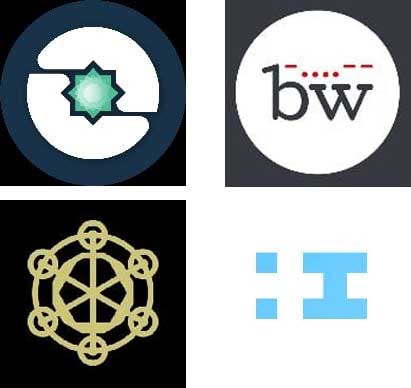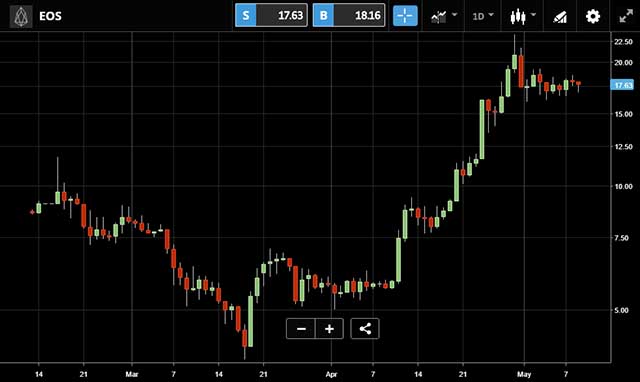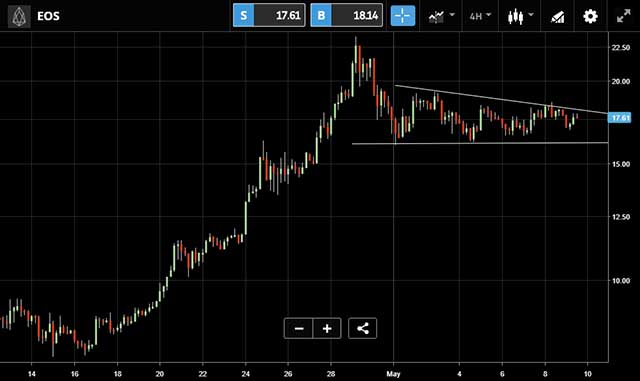eToro Market Research: EOS
EOS is by far the largest Initial Coin Offering (ICO) in the history of cryptocurrencies. Having raised more than $3.5 billion, it promises to become an extremely fast and scalable blockchain protocol with zero transaction fees. Even though the EOS main-net has not gone live yet, many believe it has the potential of becoming a standard for decentralized applications that require fast, secure and free interactions between their users.
If Bitcoin is digital gold and Ethereum is digital oil, EOS has been likened to digital real estate. The limited supply and everlasting nature of the tokens make it a prime target for investors who feel strongly about a decentralized future. However, this coin is still in the very early stages so should be approached with extreme caution and only as small part of a well-diversified portfolio.
All information is valid as of May 11th, 2018. All feedback is welcome.
History
The EOS blockchain – and the EOSIO software – is a project by a private company known as block.one that is still under development. The CTO and main mind behind the project is Dan Larimer, who is also the creator of Bitshares and Steemit, two of the most successful blockchain platforms to date. The company started the EOS Initial Coin Offering (ICO) in June 2017, which is currently running on the Ethereum network. So far, the project has raised more than $3.5 billion making it by far the most successful ICO to date.
An Initial Coin Offering (ICO) is the equivalent in the crypto-sphere of securities’ IPOs. Unlike IPOs, which are harshly regulated, ICOs are still lacking significant regulation and allow average Joe investors to support their favorite projects from a very early stage.
Some ICOs have been extremely successful, raising hundreds of millions of dollars.
Currently, EOS tokens are stored on the Ethereum blockchain. On June 1st, 2018, the EOS main net will be released and the token will be swapped onto their own blockchain. Despite not having a running product yet, EOS is currently the 5th largest cryptocurrency in terms of market capitalization, proving the great expectations of the cryptocurrency community for this blockchain.
Basic Stats
- Crypto-asset type: Utility Token
- Initial supply (June 1st, 2018): 1,000,000,000 EOS
- Circulating supply (to date): 926,000,000 EOS
- Market Capitalization: $14.2 bn
- Token Economics: Inflationary Asset
- Block producers are compensated for creating blocks with new tokens (The annual rate of inflation by new coins will be 5% but can be changed if agreed by network participants.).
- Protocol: Delegated Proof of Stake
Technical Description
The goal of EOS is to provide a blockchain platform with capabilities for smart contracts and decentralized applications. EOS will act as a decentralized operating system, similar to Ethereum or NEO, where dApps can be developed and used by the community. The project aims to create a much more scalable and flexible network than its competitors, with zero network fees and extremely fast transactions.
A decentralized application (dApp) is analogous to a software application on traditional computers and websites. Unlike these traditional solutions, dApps run on a decentralized network formed by thousands of computers.
Ethereum’s network, who currently employs a Proof-of-Work consensus protocol similar to that of Bitcoin, has proven to be slow especially during extended periods of maximum use. EOS aims to reach a capacity of millions of transactions per second, which should be enough for simultaneous and global-scale use of multiple viral dApps. For that purpose, EOS will use a state of the art Delegated Proof-of-Stake (DPoS) protocol.
In the Proof-of-Work protocol, computers in the network compete to solve mathematical problems in order to obtain rewards in the form of coins, while securing the network. A downside of this is the high costs and environmental impact in terms of energy associated with this protocol.
Meanwhile, in the Proof-of-Stake protocol, token holders are the ones in charge of validating transactions and securing the network, by staking (locking up) their coins temporarily in exchange of a reward similar to a dividend. Many people believe this new protocol will become the new standard for cryptocurrencies. Ethereum is actually scheduled to transition from Proof-of-Work to Proof-of-Stake in the future.
In the DPoS protocol, as opposed to traditional Proof-of-Stake solutions, the token holders indeed delegate the capability of producing new blocks in the blockchain to a few nodes controlled by known, trustworthy entities. This allows the system to be extremely fast, producing a new block every 0.5 seconds. At first sight, this might appear to be a less decentralized network than Ethereum or Bitcoin due to the small number of block-producing nodes. However, in practice PoW networks are oligopolized by huge mining pools that can control more than 25% of the block production, something that would indeed not happen with EOS.
On a separate note, and unlike Ethereum, which requires developers to use a specific programming language called Solidity, EOS permits dApp and smart contract development with widely used languages like C, C++ or Rust, which will make it easier for developers to deploy their projects on the network.
On both Ethereum and Bitcoin, validator nodes are compensated with coins for validating new blocks. These coins are both created with each new block (inflation) and collected from users of the network (fees). On EOS, users will simply have to own tokens to be able to use an equivalent fraction of the network resources. For example, an EOS user that holds 10% of the supply would be guaranteed 10% of the total network resources.
EOS also aims to be a much more user-friendly network than existing blockchains with usernames and accounts more similar to what the average user is used to having in traditional online services, as opposed to Ethereum’s or Bitcoin’s long hexadecimal addresses. Decentralized apps will also run natively on a simple web browser without the need for any specialized software, further bridging the gap between blockchain and non-technical users. The idea is to use the blockchain like the engine of a car. The average person doesn’t need to know how it works in order to drive the vehicle.
Token Valuation Analysis
The special token metrics of the EOS network (zero transaction fees) makes the construction of a valuation system particularly difficult. In the case of decentralized computing networks like EOS or Ethereum, the value comes in principle from the computing cost of the network. However, in practice, they will also be used as a store of value by many people, in a manner similar to Bitcoin. We also anticipate that there may be a large secondary market for developers who would like to rent EOS coins for a new project before deciding to purchase them. In that sense, it is important to take into account the inflation rate of EOS, which is decided democratically by the token holders with a maximum annual value of 5%.
The actual utility value of the network is however very hard to predict, without knowing yet the total available resources and the average use by the network users. All of these factors will be known once the main net is released and more reliable valuation models will be constructed within the next few months.
If a great number of dApps are released on the platform and prove to be successful, they will need to hold a significant amount of tokens to be able to access the network resources. Since these tokens will effectively be locked, the value of the network should indeed go up over time.
The actual value of EOS can indeed be much higher than the utility value, not only because of its potential use as a store of value but also because of the expectations of some users on the future use and capabilities of the network.
Use Cases
There are many industries where smart contracts and decentralized applications can have a disruptive effect, improving the efficiency and security of the market and eliminating the need of a centralized third-party. EOS, in particular, will be especially useful for applications where scalability and fast transactions are key and more important than having a truly decentralized system. Examples of potential applications are:
- Internet services: the blockchain-based versions of existing Internet applications would indeed require a fast, secure network with free transactions. Great examples would be social media and messaging dApps. Having a man like Dan Larimer at the head will make this use case particularly plausible given his track record. These concepts would be practically impossible in a network like Ethereum where all transactions have an associated fee.
- Peer-to-peer services, like Uber, Airbnb or eBay, could be replicated on the blockchain without an intermediary and the associated fees, and with a truly secure network. These services are becoming more and more important, and there is a huge amount of potential applications.
These use cases would be particularly suitable for a blockchain like EOS, but any application or project that could run on Ethereum or other networks could also be developed on EOS. Examples could include decentralized exchanges, financial services applications or supply chain solutions.
Development Team
The two main faces behind EOS are Brendan Blumer and Dan Larimer.

Brendan Blumer is a technology entrepreneur based in Hong Kong and the founder and CEO of block.one. He created Gamecliff, a service for selling in-game items, at the age of 14, and has since been involved with several technological projects before focusing on cryptocurrencies.

Dan Larimer is arguably one of the most respected minds in the “crypto world”. He is the creator of the DPoS protocol, and two previous successful blockchain projects, Bitshares and Steem, the two blockchain projects with a larger user activity. Now, he acts as the CTO of block.one and the main technical mind behind EOS.

Investment Risks
Trading cryptocurrencies can potentially be very profitable as seen in the past, but it is also a very challenging activity that can carry a significant level of risk. Cryptocurrency markets are associated with high volatility, and EOS is no exception.
Besides, EOS has the particularity of not having a functional network yet, with the tokens being stored as a sort of placeholders on the Ethereum network. Since it is hard to know the future performance of the network, investing at the current state can indeed be riskier than for projects whose performance is already proven.
It is important to carefully assess your investment goals, methodology and level of experience before deciding to start investing in a new market. It is also extremely important to diversify and view cryptocurrency as an additional element of your portfolio. Given the high risk associated with this type of asset, it is recommended not to allocate more than 20% of your portfolio into cryptocurrencies. Given that the possibility to lose a part or even all the money invested exists, it is extremely important to invest only money that you can afford to lose.
In any case, all the information presented in this Market Report does not constitute financial advice and introduces no obligation or recommendations for action.
Upcoming Projects
Even though the EOS main net is not yet operative, there are already some dApps in development for the network. Some of the most interesting ones are:
- Insights Network is a data exchange system, where users can manage and monetize the data they generate daily.
- Bywire is a news aggregation system with decentralized and trustless information.
- Chintai is a token leasing platform, where token holders can lend their tokens to developers or other users for a certain interest.
- Iryo is a decentralized healthcare system where medical records are stored safely and owned by each individual without the need of a centralized stakeholder.
- Everipedia is a decentralized version of Wikipedia that has the backing of Jimmy Wales, one of the co-founders of Wikipedia.
In addition, EOS will support the Bancor protocol, a new standard for the creation of a new generation of cryptoassets known as “smart tokens”. Bancor uses the concept of “connectors” to make any two tokens readily exchangeable to each other with immediate liquidity, without the need for a traditional exchange where buyers and sellers are matched.

EOS ICO & Token Distribution
The funding process of EOS, briefly described above, has indeed been one of the most interesting aspects of the project, and a unique approach in terms of how to finance an ambitious project in its first stages of development.
The one-year-long ICO that started in June 2017 is divided into one-day contribution windows that work as a sort of auction. The token (an ERC-20 token on the Ethereum network) can in the meantime be traded on several exchanges. The first period was a special one where 200 million tokens were issued raising a total of $172 million. All 349 subsequent periods have distributed 2 million EOS at varying USD rates. It should be noted that all contributions are made in Ether.
As of May 11th, there are 21 contribution windows pending (roughly three weeks) and 950 million EOS have been distributed of the total 1 billion. Of this, a 10% is reserved for block.one. With these reserves and the huge amount of capital raised during the distribution, block.one has an unparalleled treasury available for investments in the EOS ecosystem.
Future Developments & Main Net
EOS will undoubtedly experience the most important weeks of its lifetime during the next months, when the distribution period is completed and the main net is finally launched.
Tomorrow, the block.one team has just released Dawn 4.0 on May 11th. This is a new pre-release of the network with the complete set of features already implemented. Soon after the token distribution is completely finished, the main net will be deployed, and the ERC-20 “placeholder” tokens will be swapped for the actual native EOS coins. The first few days and weeks of the fully operating blockchain will be key to assess the actual performance of the network, and will likely introduce important swings in the price of the token.
Although the pre-releases mentioned above have proven successful, it will be very interesting to see if the different aspects of the blockchain (block production, smart contract deployment, dApp development, etc.) perform as expected when the network is open to the general public and under significant stress.
Market Analysis

Exhibit 1: Historical Evolution of EOS/USD price since February 2018. Note that the scale is logarithmic.
Exhibit 1 shows the historical evolution of the EOS price since February 2018 (at around $8.5) until May 2018 (currently trading around $18). In the span of less than three months, it has roughly doubled in value in anticipation of the main net, reaching an all-time high of $23.3 on April 29th.
As it is the case with the vast majority of cryptocurrencies, there is a clear correlation between the price trends of EOS and those of Bitcoin and particularly Ethereum, with which it shares a similar working concept.
April was an extremely profitable month for EOS investors, with a surge in price of over 300% in just a few weeks. The price has since experienced a pullback and is now quite stable within the $16-$19 range
Exhibit 2 shows, however, the possible formation of a descending triangle during the last week. This is a typically bearish indicator that shows how the buying pressure decreases over time and the maximums reached are lower with each bounce.
However, the price of EOS, both when looking from a short-term and long-term point of view, will definitely depend on the main net launch and the performance of the network when operational, which could render any traditional chart patterns unusable.

Exhibit 2: Evolution of EOS/USD price since mid-April, showing a possible descending triangle forming in the last few days. Note that the scale is logarithmic.
Resources
- EOSScan – Information on ICO prices
- Multicoin Capital – EOS Analysis and Valuation
- What is Bancor?
- EOS Official FAQ
- Directory of EOS-based projects
- What is Delegated Proof of Stake?
- EOS vs Ethereum for dummies
Credits
- Yoni Assia – Founder and CEO of eToro, a leader in the blockchain community for kickstarting this in-depth analysis project.
- Orit Mutznik – For her support.
- CryptoAnalyst.co – For their research and writing.
- Chris Coney
- Paz Diamont – Head of Blockchain development at eToro.
Disclaimer
Cryptocurrencies can fluctuate widely in prices and are therefore not appropriate for all investors. Trading cryptocurrencies is not supervised by any EU regulatory framework. The content is intended for educational purposes only and should not be considered as an investment advice. Your capital is at risk.
Images courtesy of eToro, Shutterstock
The post eToro Market Research: EOS appeared first on Bitcoinist.com.